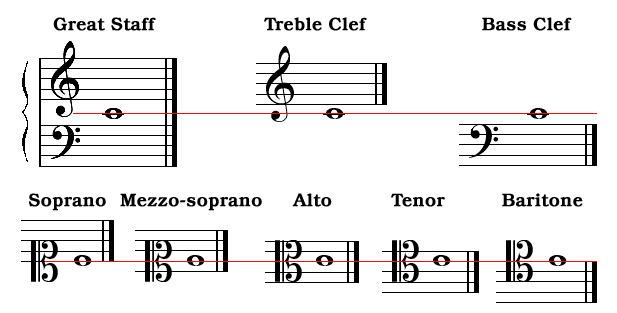

As other answers point out, those leger lines can be expanded and sometimes several are used - both above or below either clef. That's what it would be if it was on the non-existent top line, bass clef. The note under it is effectively written on the top line of the bass clef, which obviously in this music is missing! So there's middle C (top note), and on that next line down there's note A. That top note is obviously middle C, as pointed out. Sometimes, there needs to be notes lower than middle C, written 'in' the treble clef only - as in the OP's example. Hence the two parts and a floating leger line between. If there were eleven lines, it would be very difficult to pinpoint dots, so it's much simpler to have the staves split. It can be considered as the missing line out of a possible eleven, slap bang in the middle. It's always had to have its own special little line - as it does go on a line - and that line is a temporary one, which goes under the treble clef. Think about the fact that actually, middle C does not have a home. That's how it's been for many a long century. Imagine the standard grand staff, with its ten lines, split, as it is, into treble and bass clef (normally). rhythmically you will strike the two notes at the same time on the piano, probably using your thumb and middle finger, but I don't think the exact fingering is part of your question.Īfter my mild diatribe - related mainly to the fact that there were't two middle C notes, I'll attempt to make amends by answering the question. So, put that all together for your example (and add the missing clef for clarity.) The cello part below shows a clef change used to avoid going 5 ledger lines above a bass staff.įinally, middle C is C4 and depending on the clefs used it can appear on various lines of spaces. But, clef changes can be hard to read if you don't practice a lot of reading so people try to avoid them.

When starting to learn the piano, most books make their easiest pieces start on Middle C. Middle C written in the treble, alto, tenor and bass clefs. Ledger lines can be stacked above or below each other to go higher and higher or lower and lower to get to whatever pitch needs to be notated.Īnother thing that can be done to notate a note that goes off of the five lines staff is to change the clef. The Middle C sits on a ledger line(an extension of the stave written just for one note).

Ledger lines are added to a staff to go higher or lower than the 5 lines. It may seem odd, but clefs can be put on other lines and that will change the lettering of the staff. The treble clef is the "G" clef setting G4 on the 2nd line and the bass clef is an "F" clef setting F3 on the 4th line. Also, scientific pitch notation adds an octave number to letters so we know exactly in which octave a tone is. The staves take a clef to set what letters apply to the lines and spaces. I think you may be confusing the general term ledger lines with the specific middle C. There is a middle c on top of a middle c.


 0 kommentar(er)
0 kommentar(er)
